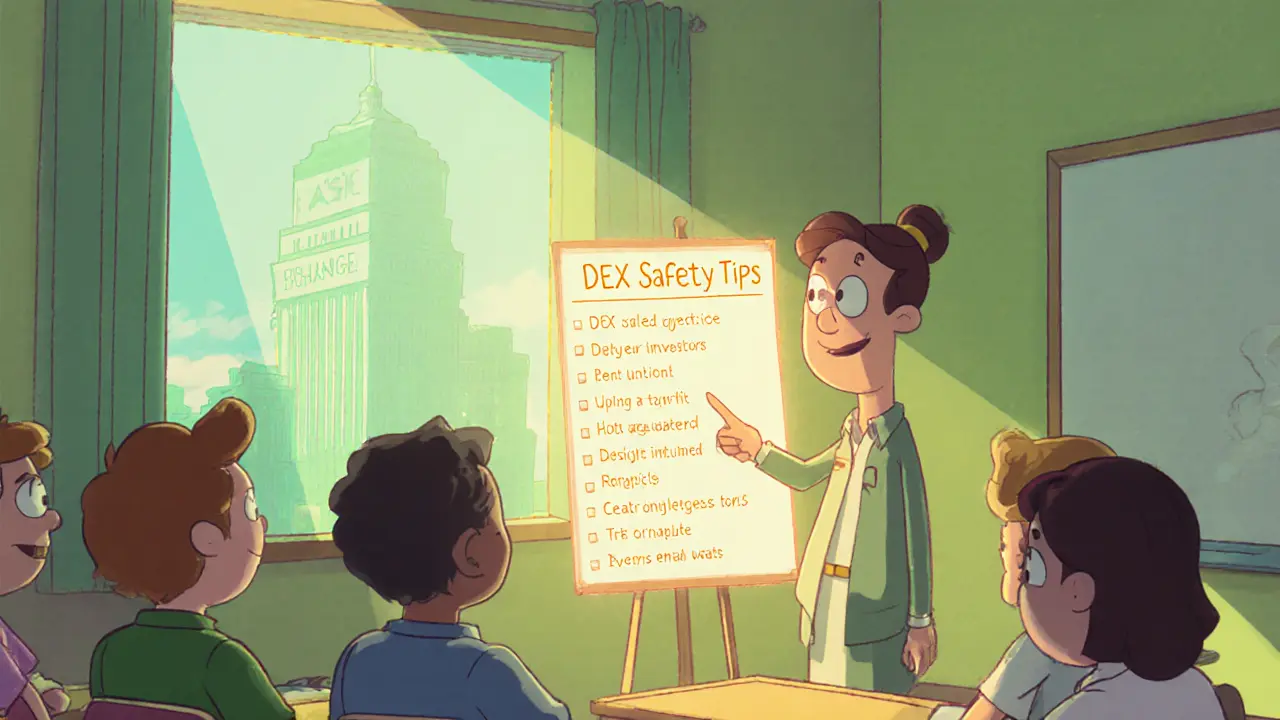DEX Safety Checker
Evaluate Your DEX
Based on the Oasis Exchange case study, enter key metrics to assess if a DEX is legitimate or potentially risky.
In early 2021, Oasis Exchange boasted a reported 24‑hour trading volume of $1.5billion. Less than a year later the platform vanished from every tracker, leaving users wondering if they had been scammed. This review unpacks what Oasis Exchange was, how it fell apart, and what traders can learn before they click “connect wallet” on any new DEX.
Key Takeaways
- Oasis Exchange launched in 2019 as a non‑custodial DEX but stopped processing trades by mid‑2021.
- CoinMarketCap listed it as “Untracked” in September 2021, a clear sign it was no longer operational.
- Typical DEX advantages (no KYC, private‑key control) were outweighed by a missing liquidity model and broken smart‑contract integrations.
- Confusion with the active Oasis Network adds to the platform’s legacy of misinformation.
- When evaluating any DEX, check on‑chain volume, active developer repos, and community support before depositing funds.
What Is Oasis Exchange?
Oasis Exchange is a decentralized cryptocurrency exchange (DEX) that launched in 2019 under the South Korean company Guardian Holdings Co., Ltd. It marketed itself as a non‑custodial platform where users retained full control of their private keys and could trade without providing personal identification.
Brief History and Milestones
- 2019 - Platform goes live, supporting ERC‑20 tokens and popular Ethereum wallets.
- Early 2021 - Reports claim a peak 24‑hour volume of $1.5B (CoinMarketCap data).
- July2021 - Last archived website snapshot; API endpoints start returning errors.
- September2021 - CoinMarketCap re‑labels the exchange as “Untracked”.
- 2022‑2025 - No on‑chain activity, domain expires, social channels go silent.
Technical Architecture
The platform followed a typical DEX stack:
- Smart contracts on Ethereum for order matching and settlement.
- Non‑custodial wallet integration (MetaMask, Trust Wallet).
- No mandatory KYC/AML for basic trades, aiming for privacy.
- Peer‑to‑peer order books managed off‑chain, with on‑chain settlement.
While these features sound attractive, the lack of a built‑in liquidity pool or token‑incentive model made it fragile. Unlike Uniswap or PancakeSwap, Oasis Exchange never introduced an automated market maker (AMM) to guarantee trade execution when order books were thin.

Operational Decline - What Went Wrong?
Cryptowisser’s September122021 review summed it up: “The trading volume at this exchange essentially means that the exchange is not operational anymore.” Several factors contributed:
- Liquidity Collapse - Reported volume dropped from $1.5B to zero within seven months. Without market‑maker incentives, order books stayed empty.
- Smart‑Contract Failures - API tests in July2021 showed unreachable endpoints; major wallets dropped support by Q32021.
- User‑Support Blackout - Trustpilot and Reddit threads from 2020‑2021 highlighted withdrawal failures and ignored tickets.
- No Development Activity - GitHub shows the last commit in August2021; subsequent releases never materialized.
- Regulatory Blind Spot - The platform never filed any AML/KYC procedures, leaving it vulnerable to jurisdictional pressure.
User Experience - Real‑World Pain Points
Archived Trustpilot reviews (average 1.8/5) repeatedly mention “non‑executed trades” and “withdrawal failures”. A Reddit user in March2021 wrote, “Can’t withdraw my ETH, the platform shows the trade but the blockchain never confirms.” CoinGecko comment sections from August2021 echo the same problem: trades appear on the UI, but on‑chain tx hashes are missing.
How Oasis Exchange Stacks Up Against Active DEXs
| Exchange | 24‑h Volume (USD) | Status | Liquidity Model | Developer Activity (2024‑2025) |
|---|---|---|---|---|
| Oasis Exchange | - (none recorded after Sep2021) | Defunct | Order‑book only, no AMM | Last commit Aug2021 |
| Uniswap | $1.2B | Operational | Concentrated AMM | 1,200+ commits in 2024 |
| PancakeSwap | $850M | Operational | Standard AMM on BSC | 800+ commits in 2024 |
| SushiSwap | $420M | Operational | Hybrid AMM + Order book | 600+ commits in 2024 |
The table makes it clear: Oasis Exchange offered none of the liquidity guarantees that keep today’s DEXs alive.
Key Lessons - Why the DEX Failed
- Unsustainable Liquidity Model - Without token incentives or a liquidity‑pool design, the order book drained quickly.
- Lack of Ongoing Development - Active DEXs keep improving contracts; Oasis Exchange’s codebase went stale.
- Poor User Support - Traders stranded with unexecuted trades lose confidence fast.
- Regulatory Ambiguity - No KYC/AML strategy made the exchange an easy target for compliance crackdowns.
- Brand Confusion - Many users mixed up Oasis Exchange with the thriving Oasis Network, leading to misinformation.

Distinguishing Oasis Exchange from Oasis Network
Despite the similar names, Oasis Network is a privacy‑focused Layer‑1 blockchain that powers active projects like YuzuSwap. As of Q22025, YuzuSwap processes about $5.9M in daily volume and benefits from a $200M Binance developer fund. Oasis Exchange, by contrast, left no trace after 2021. When researching, always verify the contract address and ecosystem affiliation to avoid this mix‑up.
Current Status - Should You Trust Any Remaining Tokens?
All on‑chain activity linked to Oasis Exchange’s smart contracts stopped in October2021. The domain expired in January2022, and Discord/Twitter accounts went silent after September2021. If you still hold tokens that were only tradable on Oasis Exchange, treat them as “orphaned assets” - you can move them to a personal wallet but expect zero resale liquidity on that platform.
Best Practices for Evaluating New DEXs
- Check on‑chain transaction volume using DeFi Llama or DappRadar.
- Review the GitHub repository - active commits indicate ongoing development.
- Look for clear liquidity‑incentive programs (yield farming, token rebates).
- Test the platform with a tiny amount before committing larger sums.
- Confirm that the project’s branding isn’t being confused with another ecosystem.
Conclusion
Oasis Exchange serves as a cautionary tale: even a DEX that initially promises privacy and high volume can disappear overnight if it lacks liquidity incentives, active development, and responsive support. By focusing on measurable on‑chain activity and community health, traders can steer clear of “ghost exchanges” and protect their assets.
Frequently Asked Questions
Is Oasis Exchange still usable in 2025?
No. All on‑chain activity stopped in late 2021, the domain has expired, and major wallet providers have removed integration. Attempting to use the platform will lead to failed transactions.
How can I differentiate Oasis Exchange from Oasis Network?
Oasis Exchange was a short‑lived DEX on Ethereum, now defunct. Oasis Network is an active Layer‑1 blockchain with its own token (ROSE) and thriving projects like YuzuSwap. Always verify the contract address and ecosystem name before trading.
What red flags should I watch for when trying a new DEX?
Look for low or missing on‑chain volume, stagnant GitHub repos, no clear liquidity incentives, and lack of active community channels. If a platform claims high volume but offers no blockchain proof, treat it with caution.
Can I recover funds that were only tradable on Oasis Exchange?
If the tokens are ERC‑20 assets, you can move them to any compatible wallet. However, there will be no liquidity on Oasis Exchange itself, so you’ll need to sell or bridge them on another platform.
Why did Oasis Exchange never adopt an AMM model?
The original roadmap focused on order‑book trading, likely to avoid the complexity of AMM math. That decision left the platform vulnerable when order flow dried up, whereas AMM‑based DEXs like Uniswap can automatically supply liquidity.




Comments
One might presume that the downfall of Oasis Exchange serves as a cautionary tale for all decentralised platforms, yet the narrative often overlooks the inherent volatility of nascent markets. In a contrarian vein, I argue that the platform's brief surge was a statistical anomaly rather than a systemic failure. Its architecture, while lacking the modern AMM paradigm, offered a unique order‑book experience that appealed to a niche cohort of traders. The abrupt cessation of activity, however, underscores the perils of insufficient liquidity incentives. Ultimately, the lesson lies not merely in the platform's demise but in the broader discourse on sustainable tokenomics.
Wake up, people! The so‑called "decentralisation" of Oasis was a front for a massive concealment operation. Hidden back‑doors in the smart contracts allowed a select few to siphon funds while the rest watched in bewilderment. The silence of the developers after the volume collapsed is classic evidence of a coordinated cover‑up. Never trust any DEX that pretends to be "privacy‑first" without verifiable audits. This is why the ecosystem is riddled with scams.
i think its important to note that the lack of community support really hurt oasis. as soon as the volume started dropping, people cant find help on discord or twitter, which is a big red flag. even tho the tech was ok, the missing support made users look elsewhere. its a simple lesson: yeah, keep the chat alive.
Folks, let’s channel that energy into building the next resilient DEX! Look at Uniswap’s continual upgrades and community‑driven liquidity pools-those are the benchmarks. If you’re passionate about decentralized finance, dive into open‑source projects, propose improvements, and rally your peers. The ecosystem thrives on collaboration, so keep the momentum alive and turn past failures into future triumphs.
Contemplating the ephemerality of Oasis, one is reminded that every digital construct is bound by the impermanence of trust. When trust erodes, the code alone cannot sustain the edifice. The paradox of a "decentralised" platform that vanishes without a trace challenges our assumptions about resilience. Yet, perhaps this void offers a space for deeper reflection on the nature of value.
🙂
The saga of Oasis Exchange reads like a modern tragedy, a cautionary epic that demands our full attention. First, the platform launched with grand promises of non‑custodial freedom, yet it neglected the essential lifeblood of any market: liquidity. Without a robust AMM or incentive program, order books withered, leaving traders stranded amid empty offers.
Second, the developers’ silence after the volume plummeted signaled a deeper governance vacuum; no roadmap updates, no community engagement, just a void. Third, the absence of KYC/AML policies, while championed as privacy, opened the door to regulatory scrutiny and potential legal action, further destabilising the operation.
Fourth, the lack of a responsive support channel amplified user frustration, turning small grievances into a chorus of dissent that quickly drowned any remaining confidence.
Fifth, the stagnant GitHub repository-its last commit a relic from August 2021-exposed an alarming neglect of security patches and feature enhancements, making the platform vulnerable to exploits.
Sixth, the brand confusion with the thriving Oasis Network sowed misinformation, causing users to conflate two distinct ecosystems and eroding trust further.
Seventh, the eventual delisting from major trackers such as CoinMarketCap was the final nail, officially branding the exchange as “untracked” and confirming its operational demise.
Eighth, the residual tokens now sit idle, orphaned assets that cannot be liquidated on the original platform, forcing holders to seek alternate venues.
Ninth, the broader lesson for the DeFi community is unmistakable: a DEX must couple privacy with pragmatic liquidity models, active development, and transparent community governance.
Tenth, aspiring projects should prioritize on‑chain volume verification, continuous code audits, and clear communication channels to sustain user confidence.
Eleventh, the community must remain vigilant, employing tools like DeFi Llama and DappRadar to monitor real‑time activity before allocating capital.
Twelfth, the narrative of Oasis serves as a stark reminder that hype alone cannot replace sound economic design.
Thirteenth, education on the nuances between order‑book and AMM architectures is essential for informed participation.
Fourteenth, regulators will increasingly scrutinise platforms that lack compliance frameworks, underscoring the importance of KYC/AML even in ostensibly permissionless environments.
Fifteenth, ultimately, resilience is forged through transparency, incentivisation, and a thriving developer ecosystem-qualities that Oasis, regrettably, never embodied.
Liquidity is king.
For anyone still scouting new DEXs, start with the basics: check on‑chain volume, scan the GitHub commit history, and verify the existence of a vibrant community. A platform that boasts zero activity on Discord or Twitter is a red flag you shouldn’t ignore. Also, test the waters with a minimal amount-if it fails, you’ll catch the issue early without a huge loss. Remember, even the most polished UI can mask deep structural flaws. 😊
It is understandable that many users felt abandoned when Oasis ceased operations; the emotional impact of losing access to funds cannot be overstated. A measured approach to evaluating future platforms-by prioritising transparent development practices and active support-can mitigate such distress. Compassionate community stewardship is essential in fostering trust within the DeFi ecosystem.
yeah its another dead project everyone forgets after the hype goes low volume less than zero not good
I hear your frustration and appreciate the candid perspective. While Oasis certainly fell short, it also highlights the importance of community vigilance. Let’s use this as a learning moment to demand higher standards from emerging platforms.
The moral imperative for any financial service, decentralized or not, is to protect its participants. Oasis Exchange’s abandonment of its users constitutes a breach of that ethical duty. When a platform disregards responsibility, it not only harms investors but also tarnishes the reputation of the broader ecosystem.
Indeed, the ethical lapse you describe raises profound questions about accountability in the cryptosphere. It seems the opportuinity to re-evaluate governance structures was missed, leading to the eventual collapse. A typo appears perhaps but the core truth remains: without proper oversight, even the most promising venture can devolve.
From a mentorship standpoint, the Oasis case provides a clear framework for guiding newcomers: first, verify the solidity of the codebase through continuous audits; second, ensure that the project maintains active developer engagement-stale repositories often precede operational failure; third, prioritize transparent communication channels, as silence breeds mistrust; and finally, encourage participation in liquidity mining programs to sustain market depth. By adhering to these principles, aspiring participants can safeguard themselves against similar pitfalls.
Adding to that, a practical tip is to monitor the contract’s transaction logs via a block explorer; anomalous patterns can signal hidden risks before they manifest publicly. This proactive stance complements the broader mentorship guidelines.
Just watching the rise and fall of these platforms feels like a rollercoaster-fun for the brave, terrifying for the cautious.
When dissecting the failure vectors of Oasis, we must deploy a multi‑dimensional analysis-considering not only liquidity scaffolding but also tokenomic incentives, governance token utility, and regulatory compliance matrices. The confluence of these vectors determines the platform’s survivability in a hyper‑competitive DeFi arena.
Your multi‑dimensional framework is intellectually elegant, yet it skirts the pragmatic reality: without a robust liquidity incentive, even the most sophisticated tokenomics crumble. The desert of community support at Oasis proves that theory alone cannot substitute for actionable engagement.